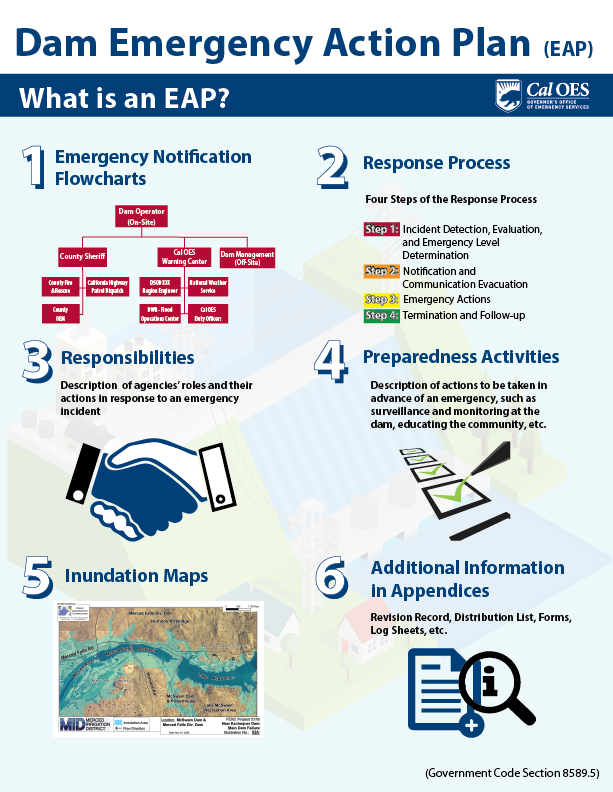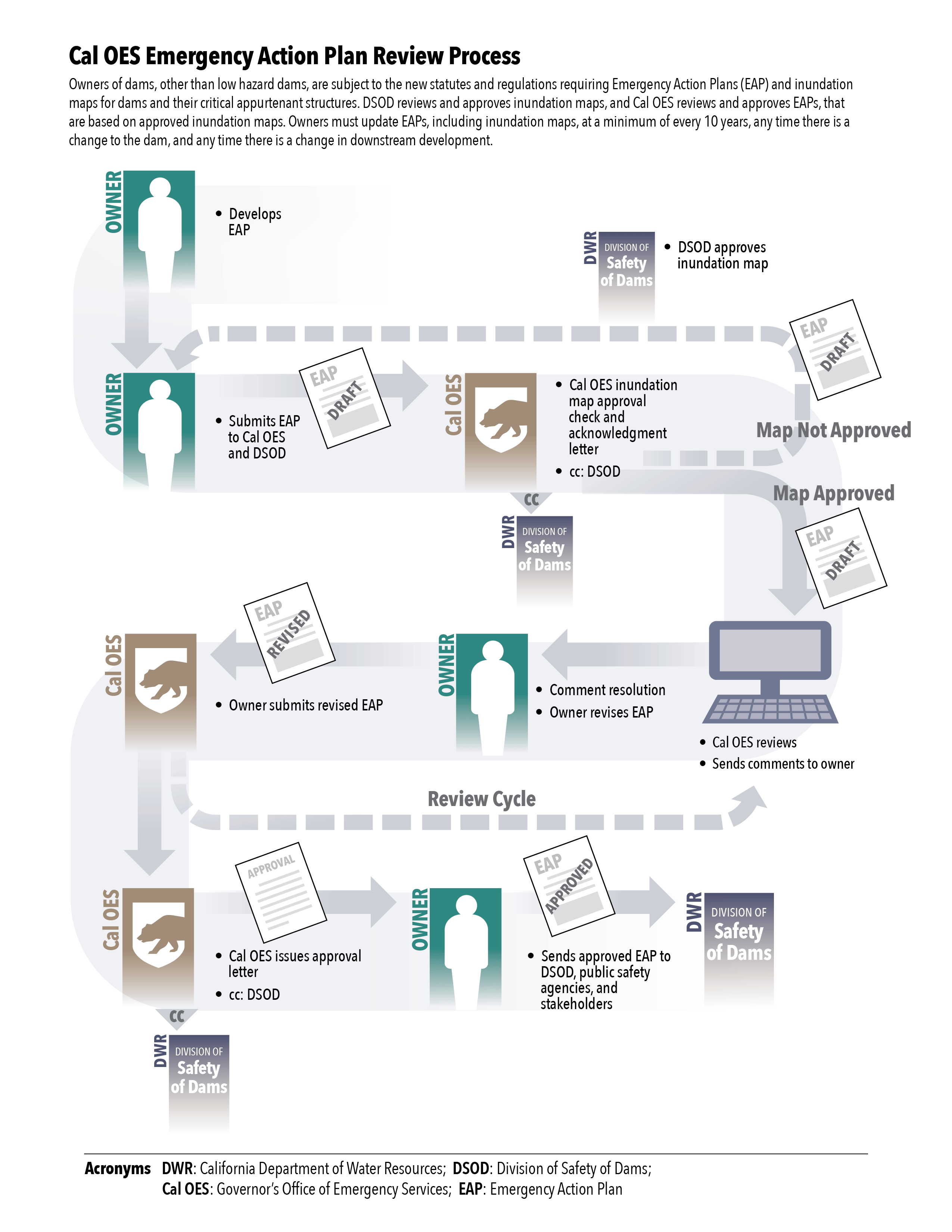Dam Safety Planning
The Dam Safety Planning Unit reviews and approves dam owners’ Emergency Action Plans (EAPs), required by Government Code section 8589.5. The EAPs are based upon inundation map(s) approved by the Department of Water Resources’ Division of Safety of Dams (DSOD) and outline actions to be undertaken during an emergency in order to minimize or eliminate the potential loss of life and property damage. The EAPs must be updated at least every ten years, and in some cases sooner. The unit provides templates and technical assistance to dam owners writing/updating the EAPs and participates in their required annual notification exercises.
Emergency Action Plan Submission Deadlines
| Hazard Classification | Deadline |
| Extremely High | January 1, 2018 |
| High | January 1, 2019 |
| Significant | January 1, 2021 |
Please submit one (1) hard copy and an electronic copy of your Emergency Action Plan to:
Electronic submission:
Hard copy submission:
Tools for Dam Owners
-
- Cal OES EAP Review Tool Updated, 2020 (PDF)
- EAP Checklist Template, 2020 (MS Word)
- Santa Luisa Dam EAP, 2021 (PDF)
Use FEMA’s Federal Guidelines for Dam Safety: Emergency Action Planning for Dams to assist and guide you in developing your EAPs. Cal OES is ready and willing to assist you through the EAP development process.
Outreach
At a minimum the following information should have been confirmed by the agencies:
• Contact information
• The notification flowcharts and which emergency levels they would like to be part of
• Responsibilities during the emergency
• The plan holders list and confirm they would like to be part of the list or if they would not
• Any other sections the agencies may be a part of. Examples include evacuation, assisting with access to the dam etc..
After all information is confirmed then it must be summarized in the EAP, it can be in a form of a chart, summary, or any other way that summarizes the information. You may also find an example in the fictional dam EAP Santa Luisa, Appendix I on our website.
Conducted outreach cannot exceed 2 years from the date of approval.
Note: Cal OES reserves the right to request documentation as proof of outreach. Examples include emails, written confirmation from an agency, or any other form of proof.
The agencies that are required are the following:
- Office of Emergency Services (OES) / Emergency Manager for each impacted city and county (If there are unincorporated areas impacted that have an OES/Emergency Manager, then they must be included too.)
- Law Enforcement for each impacted city and county (If there are unincorporated areas impacted that have a Law Enforcement/Police Department then they must be included too.)
- Fire Department for each impacted city and county (If there are unincorporated areas impacted that have a Fire Department then they must be included too.)
- California Department of Water Resources Division of Safety of Dams (DWR DSOD)
- California Department of Water Resources Flood Operations Center (DWR FOC)
- National Weather Service (NWS)
- California Highway Patrol (CHP) (If a major Hwy is impacted)
- California department of transportation (Caltrans) (If a major Hwy is impacted)
- State Park Agencies (If applicable and as needed)
- Railroad Agency (If railroad tracks are impacted. It is not required to send a copy of the EAP, these are usually only included on the flowcharts and other sections as needed)
- Downstream or upstream dam owners (It is not required to send a copy of the EAP, these are usually only included on the flowcharts and other sections as needed)
For Dam Stakeholders
Senate Bill 92, enacted June 27, 2017, added sections 6160 and 6161 to the California Water Code requiring owners of State regulated dams, except those classified as low hazard, to prepare emergency action plans (EAPs) based on dam breach inundation map(s) for emergency preparedness. The Division of Safety of Dams (DSOD) subsequently developed regulations for the development of inundation map(s) that are to be submitted to DSOD for review and approval. Dam owners are required to update the inundation map(s) and EAPs every 10 years or sooner if significant modifications are made to the dam, or if there is significant downstream development. DSOD makes approved inundation maps publicly available.
Dam owners were required to submit EAPs to the Governor’s Office of Emergency Services (Cal OES) for review and approval by deadlines based on the dam’s downstream hazard classification.
-
- Extremely high hazard dams: January 1, 2018
- High hazard dams: January 1, 2019
- Significant hazard dams: January 1, 2021
It is important to note that inundation maps must first be submitted to DSOD for review and approval, and only approved inundation maps should be contained within EAPs that are submitted to Cal OES for their approval.
Upon approval of the EAP by Cal OES, dam owners are responsible for ensuring that the approved EAP is disseminated to appropriate public safety and emergency management agencies, which includes DSOD. Thank you for your cooperation.
Dam Emergency Action Plan

Elements of an Emergency Action Plan
Cal OES Emergency Action Plan Review Process

Emergency Action Plan Review Process
Owner Education Workshop: Inundation Maps and EAPs
Thank you to everyone who joined us for the Dam Owner Workshop on inundation maps and Emergency Action Plans. We apologize for the technical difficulties that interrupted the live broadcast. You can view the entire workshop at this link: https://youtu.be/CZPvQ6yf-W0
The inundation map regulations referenced in the workshop are available at govt.westlaw.com.
DSOD and Cal OES have Frequently Asked Questions posted on their websites:
DSOD Inundation Map FAQs
Cal OES and DSOD hosted an Owner Education Workshop on January 30, 2018 to discuss new requirements for inundation maps and EAPs. The Workshop recording is below:
Tools and Resources
Dam EAPs
-
- California State Warning Center Dam Incident Form Use this form during a dam incident, drill or actual, when reporting the incident to the California State Warning Center.
- Cal OES EAP Review Tool
- Dam Division Fact Sheet
- EAP Blank Formatting Template
- EAP Checklist Template
- EAP Elements
- EAP Review Process
- Santa Luisa Dam EAP
Division of Safety of Dams
Resources
For information on what dam-related activities may be covered under the Hazard Mitigation Assistance Program, please refer to FEMA’s Analyzing the Dam Failure Hazard in the Hazard Mitigation Assistance (HMA) Program Benefit Cost Analysis (BCA).
A Guide to Public Alerts and Warnings for Dam and Levee Emergencies was created for the US Army Corps of Engineers Risk Management Center. This guidebook is for people involved with providing emergency messages and information to the public during times of impending flooding from dams and levees.
On January 30, 2018, DWR and Cal OES hosted an Owner Education Workshop about Inundation Maps and EAPs. You can find the workshop recording at https://youtu.be/_VYTeFcNIIs.
Inundation Mapping Information
For information on dam inundation mapping, please refer to the Division of Safety of Dams..
Funding Opportunities
Unfortunately, the legislature did not allocate any funds to help dam owners pay for inundation maps. Cal OES is administering several grants that may be applicable; for more information please email PDFM@caloes.ca.gov or HMGP@caloes.ca.gov.
Dam Safety Planning Inbox
California Department of Water Resources
Division of Safety of Dams
Casey Meredith
Program Manager I, Dam Safety Planning
Email: Casey.Meredith@CalOES.ca.gov
